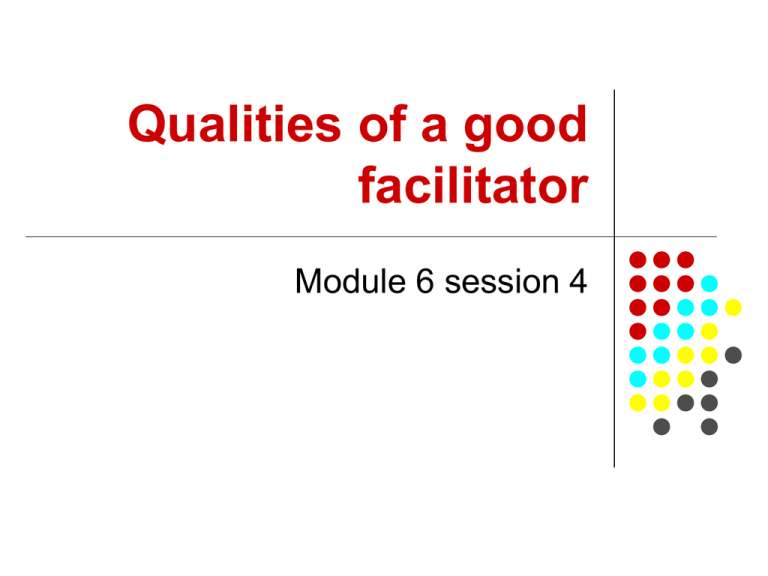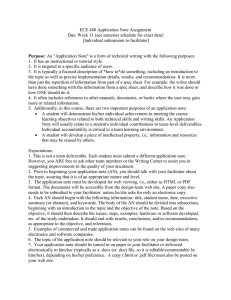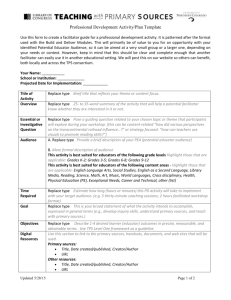Qualities of a good facilitator
advertisement

Qualities of a good facilitator Module 6 session 4 Introduction Facilitation by definition is an activity which makes easy the tasks of others. In order to assist others, it is essential to have a good understanding of how information is communicated, so that problems and questions can be addressed, and solutions found. From creating an appropriate environment so that persons of a group can generate ideas, to guiding them on decisions and conclusions, facilitation covers many areas. Facilitation skills We will now look at four skills that are essential to the success of a good facilitator These skills are: Questioning Listening Recognising and using body language Using flip charts effectively Questioning Developing good questioning skills asking and answering questions is an essential part of learning. Because of this, facilitators must plan their questions and responses carefully, so as to produce coherent thought, and aid others in understanding. Techniques for developing good questioning skills Write the question where all participants can see. Formulate questions about one event at a time Pause after asking a question to allow time for reflection Acknowledge the participants contribution Questioning techniques continued… Avoid questions that can be answered with a “yes” or “no” Encourage other responses Look for body language, which may indicate an idea Avoid questions that put others on the defensive Developing good listening skills Good listening skills are a key factor to becoming a good facilitator. In order to be a productive listener, it is important to conscribe to the following suggestions: Listening skills Listen to the words being expressed Present yourself in a manner that communicates interest and attentiveness, this helps build a rapport and encourages interaction Interact with the participant to make sure they have an accurate understanding of the information discussed Listening skills continued… Avoid emotional involvement. If you become emotionally involved while listening, you may hear what you want to hear as opposed to what is actually being said. Remain objective. Involve yourself by asking mental questions. Active listening keeps you attached to the material. While listening, try and think of what points the speaker is trying to make. Recognising & using body language to communicate Body language is an important part of communication. Therefore, understanding body language can assist you in becoming a better communicator. Recognising messages that are sent through body language will allow you to become a better sender and receiver signals. This mode of communication increases the degree of the perceived psychological closeness, between the facilitator and their participants. The following are some examples of basic body language, that convey meaning without words. A nod may indicate understanding or agreement, where as a frown may indicate confusion or disagreement Examples of body language If a facilitator looks at his/her watch while the participant is speaking the participant may think You wish I would quit talking or You’re not listening If a Facilitator looks away or does not maintain eye contact, the participant may think You are not paying attention to me or You are bored with my comments and conversation It is good practice for facilitators to maintain eye contact and nod acknowledgement so the participant knows that you are paying attention to them and their comments Areas of Nonverbal Behaviour We will now look at 5 areas of nonverbal communication. They are: Eye contact Gestures Posture and body orientation Proximity Paralinguistics Eye contact Eye contact, an important channel of interpersonal communication, helps regulate the flow of communication, and signals interest in others. Furthermore, eye contact with audiences increases the speaker’s credibility. By making eye contact, you open the flow of communication, and convey interest, concern, and credibility Gestures If you fail to gesture while speaking, you could be perceived as, stiff, or boring. Lively animated discussions facilitate learning. Gestures are also good for showing that you are listening, and engrossed in the conversation. Posture and Body Orientation You communicate numerous messages by the way you walk, talk, stand and sit. Standing erect, but not rigid, and leaning slightly forward communicates to others that you are approachable, receptive and friendly. Interpersonal closeness results from face to face communication. Speaking with your back turned away, or looking at the floor or ceiling should be avoided Proximity Cultural norms dictate comfortable interaction distances, but you should be away of some signals that indicate you are invading someone’s personal space. Some of these are: Rocking Tapping Gaze aversion This does not mean that you should stand as far away as possible. Increasing proximity allows you to make better eye contact. Be your own judge and do what feels comfortable. Paralinguistics This area of nonverbal communication includes vocal elements such as: Tone Pitch Rhythm Timbre Loudness Inflection Paralinguistics Continued… In order to communicate effectively, it is important to learn how to vary these 5 elements to infuse life into what you are speaking about. Speaking in a monotone voice can lead others to lose interest, or find the subject matter, dull and boring. Using flip charts effectively Good use of flip charts will enhance the participants understanding of the message that you are trying to get across. Below are a few tips for using flip charts effectively position flip charts where all participants can easily see. Label each sheet for purposes of easy identification. Letters should be large enough to be seen from the back of the class Using flip charts effectively continued… Use capital letters for easy reading Use think letters for easy reading Make sure to be neat Use dark colours Alternate your colours to highlight key points Use bullets to denote separate points or items Putting it all together Remember that when acting as a facilitator your job is to assist others in the task at hand, and make their job as easy as possible. Understanding how to listen, ask and respond to questions, recognize body language and use facilitator tools such as flip charts will help you in becoming an effective facilitator






